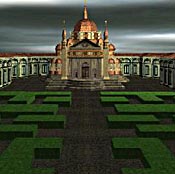Artificial realityOne of the commonest ways to think of the virtual is to conflate it with virtual reality. "VR," as it has become popularized, is a term that overtook artist and educator Myron Krueger's original, more prosaic but more accurate "artificial reality." As he put it:"The world described in Genesis, created by mysterious cosmic forces, was a volatile and dangerous place. It moulded human life through incomprehensible caprice. Natural beneficence tempered by natural disaster defined reality. For centuries, the goal of human effort was to tap Nature's terrible power. Our success has been so complete, that a new world has emerged. Created by human ingenuity, it is an artificial reality."There is a great deal of research and artistic activity going on in the realm of virtual reality. For instance, the Electronic Visualization Lab at the University of Illinois has invented an immersive space called a "CAVE," which allows for the creation of artificial realities such as Maurice Benayoun's World Skin or Hisham Bizri and Maria Roussous' Mitologies. Ars Electronica in Linz, Austria, and the NTT Inter-Communication Center in Tokyo, Japan, are two recently built museums that have CAVEs. Along with ZKM in Karlsruhe, Germany, they are working with artists to create artificial reality projects that could be considered prototypes for future virtual (artificial) museums. Nevertheless, artificial reality or VR is like the fiction of the computing world. It is a novel. And while there is often nothing truer than good fiction, the creation of fictional environments is probably not the primary trajectory for cybermuseology. At the same time, it is very likely that an increasingly real sense of immersion will be a prime trait of the digital museum. What might be other distinctive characteristics? |
 What is your favorite VR experience?
What is your favorite VR experience?
Myron Krueger and artificial reality Electronic Visualization Laboratory The CAVE (TM) is a multi-person, room-sized, high-resolution, 3D video and audio environment. It was developed at EVL. Mitologies is a virtual reality artwork created for the CAVE. It is loosely based on the Cretan myth of the Minotaur, the revelation of St. John, Dante's "Inferno", Durer's woodcuts after the revelation, and Borges' "Library of Babel." The connections between these sources are central to the unfolding of the narrative. Discussion in Shock of the View. Maurice Benayoun, World Skin NTT ICC, conFIGURING the CAVE, Agnes Hegedua, Jeffrey Shaw, Bernd Lintermann, and Leslie Stuck (music) Ars Electronica (Myron Krueger won the Prix Ars Electronica for Interactive Art in 1990)
|